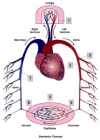Metal Nanomaterial Toxicity Variations Within the Vascular System
- PMID: 27686080
- PMCID: PMC5112123
- DOI: 10.1007/s40572-016-0112-1
Metal Nanomaterial Toxicity Variations Within the Vascular System
Abstract
Engineered nanomaterials (ENM) are anthropogenic materials with at least one dimension less than 100 nm. Their ubiquitous employment in biomedical and industrial applications in the absence of full toxicological assessments raises significant concerns over their safety on human health. This is a significant concern, especially for metal and metal oxide ENM as they may possess the greatest potential to impair human health. A large body of literature has developed that reflects adverse systemic effects associated with exposure to these materials, but an integrated mechanistic framework for how ENM exposure influences morbidity remains elusive. This may be due in large part to the tremendous diversity of existing ENM and the rate at which novel ENM are produced. In this review, the influence of specific ENM physicochemical characteristics and hemodynamic factors on cardiovascular toxicity is discussed. Additionally, the toxicity of metallic and metal oxide ENM is presented in the context of the cardiovascular system and its discrete anatomical and functional components. Finally, future directions and understudied topics are presented. While it is clear that the nanotechnology boom has increased our interest in ENM toxicity, it is also evident that the field of cardiovascular nanotoxicology remains in its infancy and continued, expansive research is necessary in order to determine the mechanisms via which ENM exposure contributes to cardiovascular morbidity.
Keywords: Cardiovascular system; Engineered nanomaterials; Metal; Metal oxides; Microcirculation.
Conflict of interest statement
Alaeddin B. Abukabda, Phoebe A. Stapleton, and Timothy R. Nurkiewicz declare that they have no conflict of interest.
Figures

Similar articles
-
Vascular distribution of nanomaterials.Wiley Interdiscip Rev Nanomed Nanobiotechnol. 2014 Jul-Aug;6(4):338-48. doi: 10.1002/wnan.1271. Epub 2014 Apr 28. Wiley Interdiscip Rev Nanomed Nanobiotechnol. 2014. PMID: 24777845 Free PMC article. Review.
-
Ecological nanotoxicology: integrating nanomaterial hazard considerations across the subcellular, population, community, and ecosystems levels.Acc Chem Res. 2013 Mar 19;46(3):813-22. doi: 10.1021/ar300069t. Epub 2012 Oct 5. Acc Chem Res. 2013. PMID: 23039211
-
Effects of acute systemic administration of TiO2, ZnO, SiO2, and Ag nanoparticles on hemodynamics, hemostasis and leukocyte recruitment.Nanotoxicology. 2015;9(8):963-71. doi: 10.3109/17435390.2014.992815. Epub 2015 Feb 11. Nanotoxicology. 2015. PMID: 25670207
-
Risk assessment of engineered nanomaterials and nanotechnologies--a review.Toxicology. 2010 Mar 10;269(2-3):92-104. doi: 10.1016/j.tox.2010.01.013. Epub 2010 Jan 25. Toxicology. 2010. PMID: 20105448 Review.
-
Toxicological aspects for nanomaterial in humans.Methods Mol Biol. 2013;948:1-12. doi: 10.1007/978-1-62703-140-0_1. Methods Mol Biol. 2013. PMID: 23070759 Review.
Cited by
-
Microvascular Dysfunction Following Multiwalled Carbon Nanotube Exposure Is Mediated by Thrombospondin-1 Receptor CD47.Toxicol Sci. 2018 Sep 1;165(1):90-99. doi: 10.1093/toxsci/kfy120. Toxicol Sci. 2018. PMID: 29788500 Free PMC article.
-
Biomedical applications of nanotechnology.Biophys Rev. 2017 Apr;9(2):79-89. doi: 10.1007/s12551-016-0246-2. Epub 2017 Jan 13. Biophys Rev. 2017. PMID: 28510082 Free PMC article. Review.
-
Nanoparticle‑based antiviral strategies to combat the influenza virus (Review).Biomed Rep. 2024 Feb 21;20(4):65. doi: 10.3892/br.2024.1753. eCollection 2024 Apr. Biomed Rep. 2024. PMID: 38476608 Free PMC article. Review.
-
Clinical and Forensic Aspects of the Different Subtypes of Argyria.J Clin Med. 2021 May 13;10(10):2086. doi: 10.3390/jcm10102086. J Clin Med. 2021. PMID: 34068024 Free PMC article. Review.
-
Maternal engineered nanomaterial inhalation during gestation alters the fetal transcriptome.Part Fibre Toxicol. 2018 Jan 10;15(1):3. doi: 10.1186/s12989-017-0239-8. Part Fibre Toxicol. 2018. PMID: 29321036 Free PMC article.
References
-
- National Nanotechnology Coordination Office. National Science and Technology Council Committee on Technology Subcommittee on Nanoscale Science Engineering and Technology; National Science and Technology Council, editor. The National Nanotechnology Initiative, Supplement to the President’s FY2012 Budget. 2012. pp. 1–50.
-
- Kirchner C, Liedl T, Kudera S, et al. Cytotoxicity of colloidal CdSe and CdSe/ZnS nanoparticles. Nano Lett. 2005;5(2):331–338. - PubMed
-
- Bystrzejewska-Piotrowska G, Golimowski J, Urban PL. Nanoparticles: their potential toxicity, waste and environmental management. Waste Manag. 2009;29(9):2587–2595. - PubMed
Publication types
MeSH terms
Grants and funding
LinkOut - more resources
Full Text Sources
Other Literature Sources

